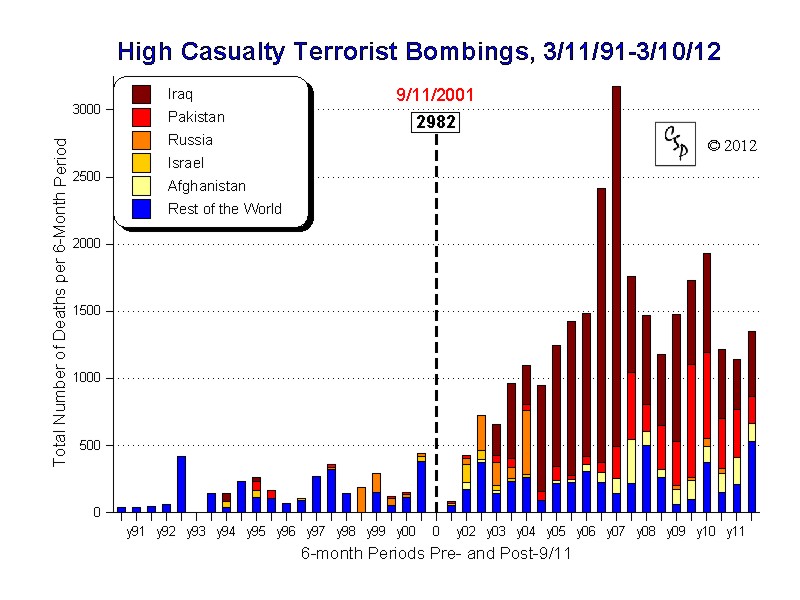The Institute for Economics and Peace has released its annual Global Terrorism Index, which gauges the impact of terrorism around the world in 2011. The findings are mapped above, with redder countries more affected by terrorism and green countries the least touched.
Here are five immediate takeaways:
1. Iraq is still first, but South Asia is overall the most terrorized region. The top-ranked countries by the frequency and severity of terrorist attacks are Iraq, which has still not recovered from the terrorism that exploded there after the U.S.-led 2003 invasion, Pakistan, Afghanistan and India. East Asia’s worst-affected country is Thailand, Europe’s is Russia, and Africa’s is Somalia followed by Nigeria.
2. Terrorism is leveling off globally, but it’s still high. The further back in time you go, the worse it looks. Here are two charts showing the trend, both emphasizing Iraq’s enormous share. The first, from the Global Terrorism Index study, shows the how high this “new normal” has become since 2007. The second, from the Center for Systemic Peace, charts only high-casualty terrorist bombings. That’s a more limiting metric, though one that tells a more pointed story: a global decline in such incidents, which perhaps augurs a larger trend in terrorism.
3. Yes, terrorism is predominantly by religious groups. The study identified which groups were responsible for which attacks, and then divided those groups by ideology: religious, political or nationalist/separatist. That’s never a perfect division, and some of the nastiest groups tend to encompass all three ideologies, hence widening their appeal and support base. Still, however rough a metric, it’s interesting to see both the long predominance of religious groups and the apparent rise of political groups.
3. Terrorism’s greatest decline was in the United States. The study found that North America was the region least likely to suffer from terrorism from 2002 to 2011. For all the threats made against the U.S., it suffered only 23 terrorism deaths on U.S. soil in those 10 years. The three most frequent perpetrators: the Earth Liberation Front, Animal Liberation Front and anti-abortion activists. The scariest groups – al-Qaeda and affiliates, the Taliban and affiliates, the KKK and affiliates – made up less than 3 percent of attacks in the past decade. Even with this high bar on safety, the study on terrorism impact found that the greatest improvement in any country from 2010 to 2011 was in the U.S.
4. Much of Africa is quite safe from terrorism. This is a point you’ll see me repeat, but sub-Saharan Africa is often unfairly perceived as synonymous with its conflict spots. Those conflicts are serious and not few: Somalia’s fighting has raged for years, Nigeria’s Christian-Muslim violence may be worsening, and neither Mali nor Congo show many signs of improving. But wide stretches of the continent, particularly in its west and south, are doing relatively well.
5. Conflicts do end and violence isn’t forever. This might seem obvious, but it’s worth pointing out that some of the countries that suffered from the worst and most frequent terrorist attacks only a few decades ago are now much more peaceful. This is especially true in such Central American countries as Nicaragua, El Salvador and Guatemala. It’s easy to believe that some places are just naturally more violent than others – particularly given how long violence has marked the Middle East and in South Asia – but there’s nothing about these conflicts, any more than those of the 1960s and ’70s, that makes them necessarily permanent.







